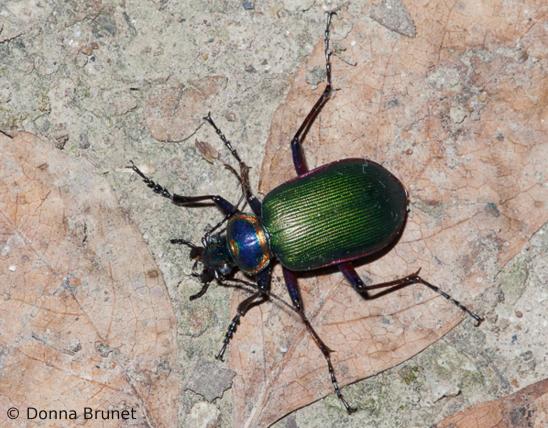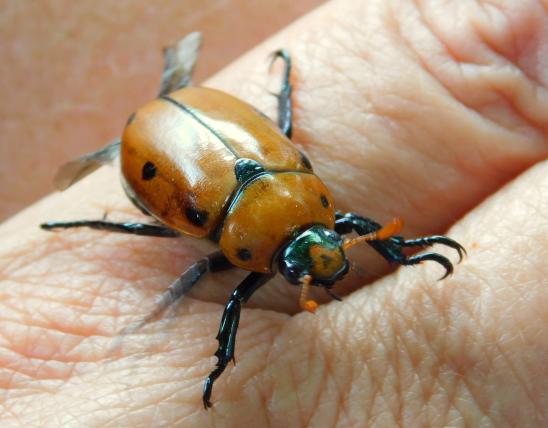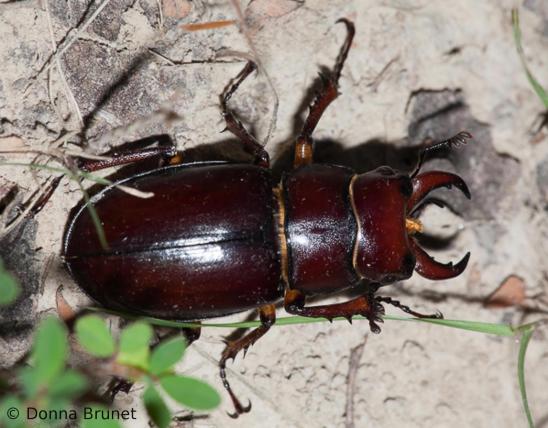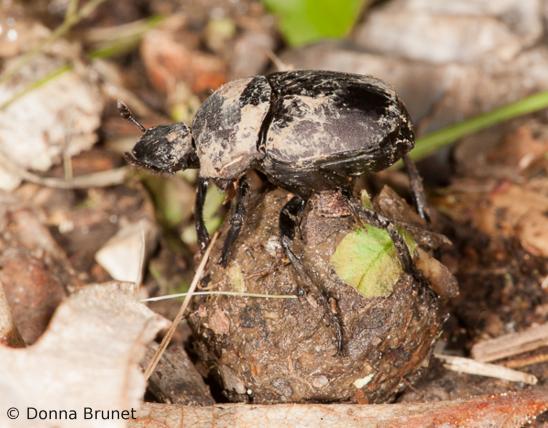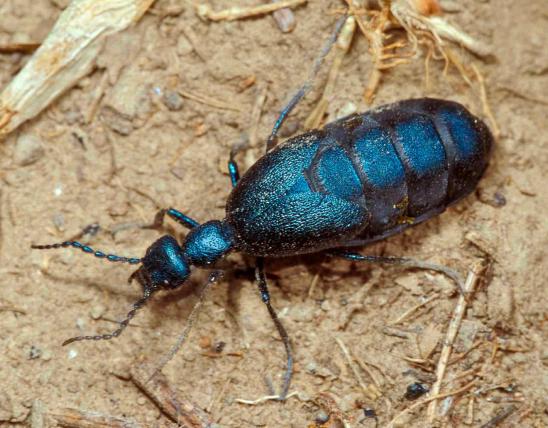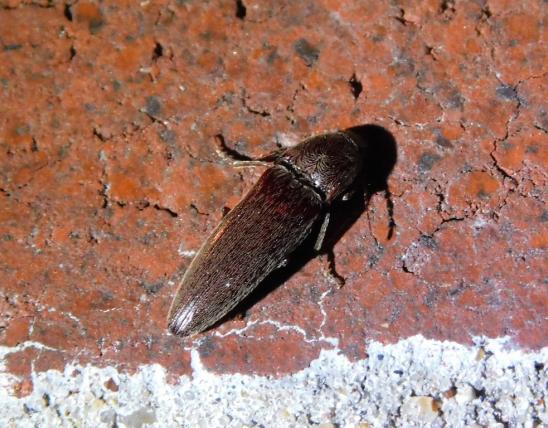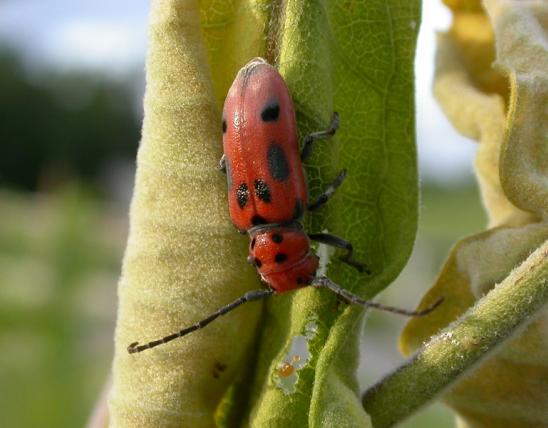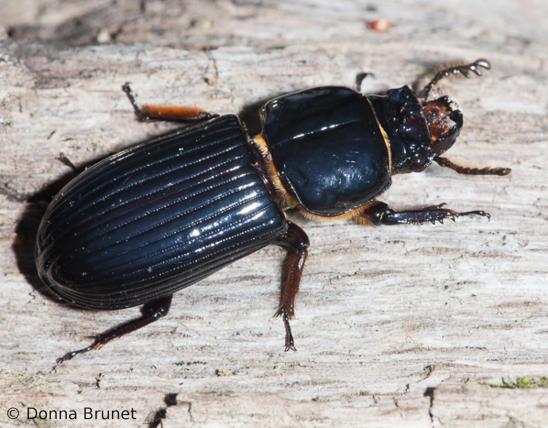
Darkling beetles are a very large family of beetles. Most are dull black or brown, crawl on the ground, and are scavengers. Many of them — lacking remarkable colors, pincers, horns, or odd-shaped antennae — resemble what you might call a “base-model” beetle, or a beetle’s beetle.
Since they’re sort of “normal-looking” beetles, how do you tell if a beetle is a darkling beetle? There are a suite of characters that, taken together, help ID beetles in this group:
- Color: typically black or brown, often dull, sometimes shiny; sometimes with other patterns or colors (notably red). Some have fine hairs or a fuzzy or waxy coating.
- Size and shape: Varies widely. Most are oval or elongated. Globally they range from extremely tiny to 3 inches; in our region, the largest are only to about 1½ inches.
- Texture: the cuticle (exterior) is hard and thick. The surface is sometimes smooth, sometimes lumpy or knobby, sometimes ridged or pitted.
- Head: fairly wide, rounded in front; the jaws are not easy to see from above (unlike the easy-to-see pincerlike jaws of ground beetles, tiger beetles, and stag beetles).
- Antennae: usually with 11 segments; appear beadlike or threadlike; often slightly clubbed (with the outer segments gradually wider). One subgroup has the outermost antennal segment elongated. The antennae emerge from beneath a shelflike structure in front of the eyes.
- Eyes: the shelflike structure in front of each eye intrudes into the eye, making the eye appear notched (not perfectly rounded or oval).
- Feet (tarsi): the front 2 pairs of legs have tarsi with 5 segments; the back pair of legs have tarsi with 4 segments.
- Locomotion: Usually by walking. Some species can fly and may be attracted by lights at night. Many species are flightless; some have the elytra (shell-like forewings) fused together, with no visible split down the back. The ones with fused forewings are especially common in desert habitats.
Larvae are hard-bodied, cylindrical, with 6 short legs behind the head; they drag the long hind portion of the body along. If you are familiar with mealworms, picture them: mealworms are the larvae of certain types of darkling beetles. The larvae of some types of darkling beetles are called false wireworms, because they can resemble the larvae of click beetles (called wireworms).
Adult length: in our area, they range from very tiny (less than ¼ inch) to about 1½ inches. Globally, they may be more than 3 inches in length.
Statewide. Different species may have varying habitat preferences, thus different distribution patterns within the state.
Habitat and Conservation
Darkling beetles most typically live on the ground, under and around rocks, logs, leaf litter, garden mulch, and so on. Some live under the bark of dead trees. Some burrow into shelf fungi and other mushrooms.
This is a worldwide family whose members are most abundant and diverse in arid regions, such as the American desert southwest. But there are plenty of species that occur in moister, more temperate regions such as ours.
Food
Foods vary widely. Darkling beetles, as adults and larvae, have chewing mouthparts. Most are scavengers, especially of plant material, living on the ground amid leaf litter, rotting logs, or under and around rocks. Some eat dead animals, including other insects. Some eat fungi, especially certain species that live beneath the bark of dead trees. Some eat living vegetation and can be agricultural pests. The larvae of some darkling beetles are called mealworms because they are infamous pests of stored grains.
Status
The darkling beetle family is very large and diverse. Some species are agricultural pests. Some are notorious for attacking and spoiling stored grains and flour. Some species are economically important as food for pets, wildlife, and even people. Some are important in research. Most are humble scavengers, living their lives completely unnoticed by people.
The darkling beetle family is one of the largest families of beetles. Globally, there are about 20,000 species; in North America north of Mexico, there are about 1,200 species. In the eastern United States (east of the Mississippi River), there are about 225 species; west of the Mississippi River, about 1,000. In Missouri, there are probably about 25 species.
The darkling beetle family, as it is now understood, includes two groups that were once considered separate families:
- The comb-clawed beetles (formerly family Alleculidae, now subfamily Alleculinae) have tiny combs on the claws of their feet.
- The long-jointed beetles (formerly family Lagriidae, now subfamily Lagriinae) have the outermost segment of the antennae especially elongated; also, the main part of the body (the shell-like elytra) is typically widest at the hind end and narrower toward the front; the head and the necklike pronotum are both about the same width, both being narrower than the elytra.
Life Cycle
Darkling beetles have the same general life cycle as other beetles. Eggs hatch into grublike larvae, which grow and molt a number of times before they become a pupa. As with the cocoon of moths and chrysalis of butterflies, the pupa of beetles is an inactive stage. When the pupation stage is complete, the sexually mature adult beetle emerges. Some darkling beetle species can have a lifespan of several years.
Human Connections
Perhaps the most famous darkling beetles are mealworms. The larvae of the yellow mealworm beetle (Tenebrio molitor) are the well-known, grublike insects sold as foods in pet stores. They are sold live (usually packaged in oatmeal or bran) or dried.
- Yellow mealworms are used for feeding poultry, backyard birds such as bluebirds, and pet reptiles, amphibians, and fish. They are also sold as bait for fishing.
- Because they are so easy to rear and handle, they are also used in a wide range of biological studies.
- The species occurs globally but is probably native to the Old World. It has been a grain pest for millennia.
- Eventually, if left alone, a container of yellow mealworms will turn into a container of black adult beetles. But in the 1980s, so-called giant mealworms became commercially available. These mealworms are fed a juvenile hormone, which prevents them from pupating and becoming adult beetles; instead, they just keep growing and molting into larger and larger larvae.
- Yellow mealworms are quite nutritious, easily reared, and edible for people. They are eaten in southwest Asia, Japan, and, increasingly, in Europe.
- Researchers have found that yellow mealworms can eat and digest (and degrade) polystyrene plastics (the kind of plastics used in CD jewel cases and Styrofoam). This holds great potential for reducing plastic wastes, which otherwise can persist in the environment for a very long time.
Another mealworm species, called superworms (Zophobas morio), also can eat and degrade polystyrene. They grow to a large size without juvenile hormone, and they, too, can be eaten by people as well as by pets and poultry.
The lesser mealworm (Alphitobius diaperinus) is an infamous pest of stored grain and of poultry farms. It lives in poultry litter. These insects eat the birds’ food, bite the birds, and can even chew enclosure materials, causing damage. They can transmit more than 30 diseases of poultry. Like other mealworms, the larvae can be used to feed pet reptiles and amphibians.
Some other notable darklings are about three species of flour beetles (Tribolium spp.), which occur worldwide. They are tiny (⅛–¼ inch long) and are infamous for infesting flour and other milled or broken grains, plus dried fruits, shelled nuts, and so on. You might have seen these miniature beetles in your kitchen pantry or in bags of stored dog or cat food. They also occur in grain silos, food warehouses, and grocery stores. Their bodies, bad-smelling secretions, and feces spoil food, and their presence increases the growth of mold. They cannot feed on whole, unbroken grain.
Some types of darkling beetles (especially some of the desert-adapted species) have become popular as pets and can live in captivity for several years.
Many darkling beetles are specially adapted for desert life. Some of these, which live in the Namib Desert in southern Africa, can harvest water from fog. The beetles (Onymacris spp.) perch on the ridges of sand dunes and raise up their hind ends, so their backs are facing the wind. The surfaces on their shell-like elytra cause tiny water droplets to collect, and moisture seeps down the surface of the insect, forming a droplet of water at the mouth. This behavior is called fog-basking. People are studying the precise surface texture that works so well for these beetles. Applied on a larger scale, biomimetic technology based on these beetles can potentially help people to survive in desert regions, where there is fog but little water.
In his novel Cannery Row, John Steinbeck describes the uplifted-tail behavior of certain types of darkling beetles often called skunk beetles. Two characters call them “stink bugs” and ponder the reasons for the behavior; they wonder if the insects are praying. We now know that it’s a defensive posture, similar to a skunk turning around and lifting its tail.
The skunk beetles of the desert southwest are also called pinacate beetles, from the Mexican Spanish word for “acrobat” or “tumbler,” for the way the skunk beetles perform near-headstands. The Pinacate Peaks of northern Sonora, Mexico, along the Arizona border, are named for these beetles; in Spanish, the mountains are the Sierra Pinacate. In Native American folklore of the desert southwest, these headstanding beetles are said to be listening to spirits.
“Tenebrionid” is pronounced “tuh-NEE-bree-ON-id.” The family name, Tenebrionidae, is from the genus name Tenebrio, established by Carl Linneaus in the 1700s. Tenebrio is Latin for “seeker of dark places,” and “darkling” is an English-language equivalent. The Latin word tenebrae means “darkness.” You may have heard of Christian Good Friday services called tenebrae services; often in these, candles, one by one, are extinguished as the story of Christ’s death is described, leaving the congregation in darkness.
Ecosystem Connections
Darkling beetles are scavengers and plant-eaters that are eaten by a wide variety of insectivores. Their many defensive strategies, including simply playing dead, are a reminder that these beetles are hunted as prey.
A notable darkling species is the forked fungus beetle (Bolitotherus cornutus), the only member of its genus. It occurs in Missouri. Adults and larvae eat hard bracket fungi, especially Ganoderma species such as the artist conk and ling chih, which grow on living and dead hardwood trees. These beetles burrow around in the mushrooms or hide in nearby bark or wood crevices. The adults, less than ½ inch long, are brown, with a distinctive, crusty appearance, with rough, knobby backs. Males have a pair of thick, forward-pointing, slightly downturned horns on the prothorax (arising just behind the head). There is fuzz on the bottom surface of the horns. The horns are apparently used in courtship, male-male competition, or both. When disturbed, this species tucks its legs into perfectly shaped grooves in the underside of the body and plays dead. Cute as they are, they are virtually impossible to find if they fall onto the ground; they look just like a tiny clod of dirt.
Worldwide, darkling beetles are most abundant and diverse in dry regions, particularly deserts. Desert-dwelling darkling beetles have many fascinating adaptions for survival:
- Skunk beetles, also called stink beetles, pinacate beetles, or headstander beetles (genus Eleodes), live in the desert southwest. Their shell-like elytra are completely fused into a single rounded shell, so they cannot fly — but this adaptation helps them reduce water loss. When disturbed, these species raise their hind ends, aimed toward their attacker, and can emit or spray bad-smelling, noxious chemicals in defense. Grasshopper mice get around this by shoving the beetle tail-first into the ground, then chew on the head and foreparts. When scorpions capture skunk beetles, they hold and eat them with the noxious hind end pointed away.
- Considering that skunk beetles are pitch black, and are not camouflaged against the tan desert soil, biologists suspect the black coloration is a warning to predators, making their trademark posture easy to see and remember.
- In addition to the skunk beetles, other beetles (some species of darklings as well as at least one species of longhorn beetle) mimic the ones that stink. These black beetles generally resemble the skunk beetles, and they perform the same tail-raising behavior, even though they cannot emit defensive chemicals. Many predators avoid them as they would avoid the skunk beetles.
- Another group of nifty darkling beetles native to the desert southwest are the death-feigning beetles (Asbolus spp.). They play dead when frightened, going rigid, falling over, sometimes twitching their legs spasmodically. The blue death-feigning beetle (A. verrucosus) has a bluish-white, waxy coating that prevents moisture loss and acts as a sunscreen.
- Pie-plate or pie-dish beetles (Helea and Pterohelaeus spp.) occur in Australia and Africa. They, too, are adapted for dry environments. They are shaped like pie plates, with a flattened, upraised rim all around their bodies. This shape apparently helps them remain above shifting sands while also allowing them to settle down just below the sand’s surface (much as a stingray, sole, or flounder can wiggle around to be just under the sand in seawater). In some pie-plate beetles, the body shape helps them slide under the loose bark of trees. The body shape may also help them collect water, and it may protect them from predators.
- See Human Connections above for the water-harvesting behavior of Namib Desert beetles, whose adaptations may be teaching people how to acquire water in fog deserts.




























